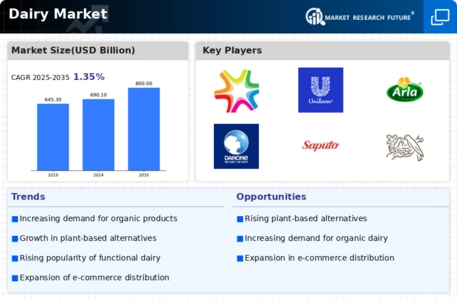Evolving Consumer Preferences
Evolving consumer preferences significantly influence the Dairy Market. There is a marked shift towards convenience and ready-to-eat dairy products, as busy lifestyles drive demand for on-the-go options. Products such as single-serve yogurts and cheese snacks are increasingly popular among consumers seeking quick and nutritious choices. Additionally, the trend towards clean label products, which emphasize transparency and minimal processing, is reshaping the Dairy Market. Consumers are more inclined to choose dairy items with simple ingredient lists, reflecting a desire for authenticity and quality. This evolution in preferences compels dairy manufacturers to adapt their offerings, ensuring they align with consumer expectations for convenience and quality.
Increasing Health Consciousness
The Dairy Market experiences a notable shift as consumers become increasingly health-conscious. This trend is reflected in the rising demand for low-fat and organic dairy products, which are perceived as healthier options. According to recent data, the organic dairy segment has seen a growth rate of approximately 10% annually, indicating a strong consumer preference for products that align with health and wellness goals. Additionally, the popularity of probiotic-rich dairy items, such as yogurt, continues to rise, as consumers seek functional foods that support gut health. This growing awareness of health benefits associated with dairy consumption is likely to drive innovation and product development within the Dairy Market, as manufacturers strive to meet evolving consumer preferences.
Rising Demand for Dairy Alternatives
The Dairy Market is witnessing a rising demand for dairy alternatives, driven by changing consumer preferences and dietary restrictions. Plant-based milk alternatives, such as almond, soy, and oat milk, have gained substantial market share, appealing to lactose-intolerant individuals and those adopting vegan lifestyles. Recent statistics indicate that the plant-based milk segment has grown by over 20% in the past year, reflecting a shift in consumer behavior. This trend prompts traditional dairy producers to diversify their product offerings, incorporating plant-based options to capture a broader audience. As the market for dairy alternatives expands, it presents both challenges and opportunities for the Dairy Market, necessitating adaptation and innovation.
Sustainability Initiatives in Dairy Production
Sustainability initiatives are becoming a focal point within the Dairy Market, as consumers and regulators alike emphasize environmentally friendly practices. Dairy Market producers are increasingly adopting sustainable farming methods, such as regenerative agriculture and waste reduction strategies, to minimize their environmental footprint. Recent data suggests that dairy farms implementing sustainable practices can reduce greenhouse gas emissions by up to 30%. This commitment to sustainability not only addresses consumer concerns but also enhances brand reputation and loyalty. As the demand for sustainably produced dairy products rises, the Dairy Market is likely to see a shift towards more eco-friendly practices, influencing production methods and consumer choices.
Technological Advancements in Dairy Production
Technological advancements play a crucial role in shaping the Dairy Market. Innovations in dairy farming techniques, such as precision agriculture and automated milking systems, enhance efficiency and productivity. These technologies not only improve milk yield but also ensure better animal welfare and sustainability. For instance, the implementation of data analytics in herd management allows farmers to optimize feeding and breeding practices, leading to healthier livestock and higher-quality milk. Furthermore, advancements in processing technologies enable the production of a wider variety of dairy products, catering to diverse consumer tastes. As these technologies continue to evolve, they are expected to significantly impact the Dairy Market, driving growth and competitiveness.


















Leave a Comment